On 10 May 1876, U.S. president Ulysses S. Grant opened the Centennial Fair in Philadelphia’s Fairmount Park. The fair, to which some ten million tickets were sold over its six-month run, is often described as the first world’s fair in the United States.1 Other fairs had been held earlier, but this was the first to give such prominence to products from other countries. Hard on its heels, a nearly unbroken series of fairs opened in various cities across the United States, some local and some with national reach, with Syrian Arabs participating in almost every one of them.
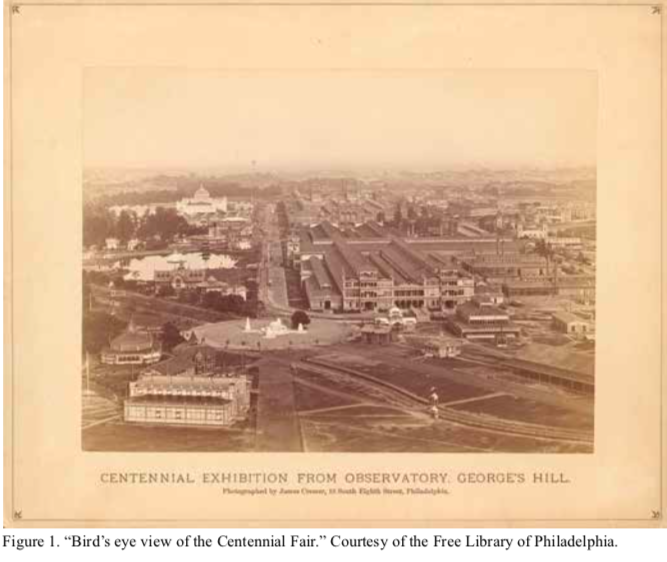
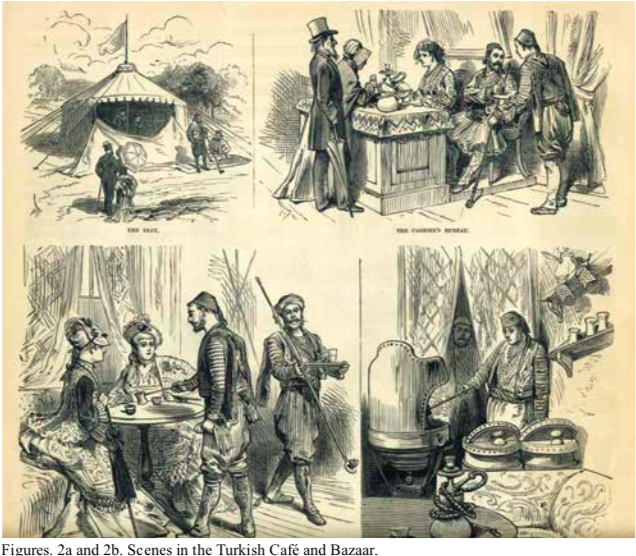
Most of the fairs exploited the Orientalist fad that was sweeping the country, selling Middle Eastern goods and replicating mosques, Cairene streets, and Turkish cafés, culminating in the full-scale replica of the Old City of Jerusalem at the 1904 St. Louis fair. Middle Easterners performed in costume as camel drivers, shaykhs, belly dancers, or Bedouins, many taking on multiple roles. Merchants, too, were expected to wear “native dress,” and they themselves believed this helped sell their wares. The Centennial Fair led the way, being the first in the United States to invite “native” merchants to show Holy Land goods, not only introducing these goods to an American public already in thrall to the “mystic East” and the Holy Land, but also introducing Palestine merchants to a large and hitherto unexploited market, enabling the global expansion of trade in these goods.

The Ottoman government responded positively, but quite late, to an invitation to participate in the Centennial Fair. A committee headed by Aristarchi Bey, the Ottoman ambassador in Washington, was set up in the United States to manage arrangements on the American side, assisted by the first and second secretaries, Xenophon Baltazzi and Ahmed Rustem (along with the acting consul in New York City, Edward Sherer).2 Ultimately, the Ottoman section opened two months after the fair’s inauguration in May.3 The fair’s governing body, the United States Centennial Commission, had allocated only three thousand square feet of space to “Turkey” in the main exhibition building, half the space given to Egypt.4 An astonishing fifteen hundred exhibitors – both provincial governments and private individuals or companies – showed a broad range of products from all over the Ottoman Empire, from sea salt to silks, saddles to soap.5 The largest number of goods were textiles, followed by agricultural and food products, and leather goods. Two stuffed Angora goats were on display in a glass box, and exhibitors submitted portfolios of photographs and treatises on the medical and natural sciences.6
Only four exhibitors from Palestine – all from Jerusalem – were listed in the official catalogue of the Ottoman section of the main exhibition building, although newspaper accounts mention articles of olive wood inlaid with mother-of-pearl (including “a model representing the inside of a mosque at Jerusalem”) that may have come from Bethlehem.7 Of the four, the largest was Vester and Company, owned by Ferdinand Vester, a German cabinet-maker who had gone to Jerusalem in 1853 to join the Swiss- German Mission.8 The other exhibits from Jerusalem in the Ottoman installation in the main building were tiny in comparison to Vester’s: the government of Jerusalem showed a single “earthen[ware] cup”; one Cherkis Berke sent mother-of-pearl lockets; and an enigmatic entrant, “Ith,” displayed a ceramic cup and saucer. Ana Sebat (said to be from Jerusalem but most probably from Bethlehem) created a mother-of-pearl mosaic of the “Tomb and Sepulchre of Christ,” which was displayed in the women’s building. No other exhibitors from Palestine are listed.
THE BAZAARS
The main exhibition building was one of five major buildings dominating the fair, but many other impressive structures – both government-built and those erected by businesses – were placed about the grounds. Dozens of smaller buildings went up wherever there was an empty space, offering entertainment, food, and goods for sale.10 Although their locations and designs had to be approved by the Centennial Commission, there was little logic to their placement and no uniformity of design, so they added visual variety to what might have been a staid, albeit grand, exposition. After initial approval, these small installations were generally ignored by the authorities (unless they transgressed some rule or did not pay rent on time). They did not appear in official depictions of the fair and were not eligible for awards.
The Ottoman government was assigned an additional 4,200-square-foot plot of land in the southwestern section of the exposition grounds between Fountain Avenue and Avenue of the Republic to build a Turkish café and bazaar. George H. Boker, the U.S. ambassador in Constantinople, had told the Centennial Commission that it would be “a small, one-story building, and it is very pretty and characteristic, being an exact copy of one of the Sultan’s kiosks.”11 Designed by Pierre Montani (the architect of several previous fair installations), the building was fifty feet square, with a kitchen protruding at the back. Its octagonal roof topped with a small dome and a standard bearing the star and crescent gave it its “Oriental” appearance. Echoing the roof’s shape, the café served Turkish sweets and coffee along with Cypriot and Samos wines, and the smoking parlor offered men narghiles and chibouks filled with Turkish tobacco.12 Opening out from the café onto the surrounding porch, four bazaars sold antiques, gold and silk embroideries, carpets, and “different Brousse, Damas, and Syria Stuffs.”13
The romantic lens through which the Turkish Café and Bazaar were first seen gave way to malicious innuendoes. A strange spate of thefts occurred at the bazaar near the close of the fair; all the thieves were apparently well-heeled Americans and all were acquitted. The papers accused the merchants of having concocted the thefts in order to extort money from the Americans.14 Other stories claimed that the merchants were not Turks, but Greeks, implying that the public was being fooled; the items they sold were fake; and the prices they charged were outrageously inflated. The director-general himself got involved and wrote to Baltazzi, asking him to stop unauthorized vendors from selling in the bazaar, and to Aristarchi, advising him that the café was behind in its rent payments.15 These difficulties may have signaled a failing enterprise or may have simply represented the conflicting attitudes of Americans toward “the East”: fascination on the one hand and contempt on the other. Just north of the Turkish Café, on the same side of Fountain Avenue, were the Jerusalem and Bethlehem Bazaars – two wooden booths “designed for the sale of olive wood” and given the catalogue numbers of 531⁄2 and 581⁄2, respectively.16 Too small to appear on maps or photographs, several eyewitness accounts attest to their existence.
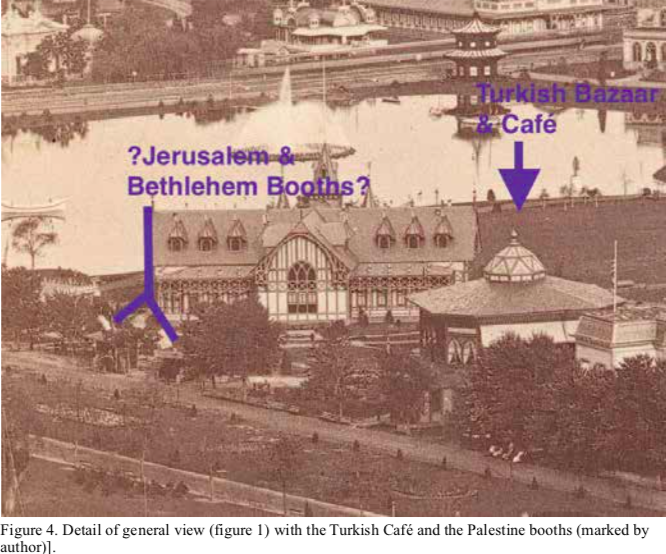
The Jerusalem Bazaar The Jerusalem Bazaar went up first (as indicated by its smaller catalogue number and several newspaper accounts), opening on 18 May. Measuring a mere fourteen by eight feet, it was gaily painted in shades of green, yellow, blue, and gold, and sold only goods carved from olive wood: “crucifixes, rosaries, card and cigar cases, match-boxes and gew-gaws . . . all made, [said] the Syrians, of wood from those spots in the Holy Land which are so dear to Christians.”17 Bayard Taylor, the famous travel writer, visited the booth and attested to the genuine quality of the objects, in contrast to the “cheap jewelry manufactured in Paris” for sale in the Tunisian Bazaar.18 “As honey-bees cluster upon rhododendrons so do Exhibition visitors flock about the Syrian bazaar, trying to read the placards and labels displaying Turkish characters descriptive of the wares offered for sale by five natives of Jerusalem rigged in full Syrian costume.”19
The five managers of the Jerusalem Bazaar were four brothers in their twenties – Nachly (28), Abraham (22), John (25), and Jacob Abdelnour Kurt (25) – and David Nassar Jamal (age 26), all of whom had traveled from Jerusalem by way of Germany, boarded the SS Pennsylvania in Liverpool and landed in Philadelphia on 3 April.20 They came to the attention of reporters, not least because they were dressed in the “peculiar costume of their country.” Jamal, a guide for English and American tourists in the Holy Land, was assumed to be the boss, because he spoke English and apparently did “nothing but smoke a short wooden pipe and act as a cicerone to the curious gazers standing around” while the other men worked.21 It may be that the Kurts brought Jamal along because of his knowledge of English, or perhaps he really was the boss, as the reporter assumed. When asked whether they were Christians or Muslims, Jamal exclaimed, “Christians! We are Orthodox, every one of us!”22 It is also not clear who owned the booth and goods (they may have even been in Vester’s employ), but the name ascribed to it by several reporters – Nachly & Bros., Jerusalem – seems to indicate the brothers worked for themselves. Skilled carpenters, these men may also have carved the objects they sold.
Four months after arriving in the United States, all but Jacob filed papers declaring their intention to become citizens. Nachly and Abraham signed with their mark, John in Arabic, and Jamal in English.23 After the fair closed, however, all except Nachly returned to Jerusalem. Jamal sold “Oriental curios” in Jerusalem and England and served as dragoman for many eminent Holy Land tourists. He and his partner, Demetrius Domian, boldly advertised their services on the Jaffa Gate, directly under the advertisement for Cook’s.24 Nachly became a carpenter in Boston; he was naturalized in 1883, so that he could obtain a passport and return home temporarily. When he went back to the United States, he settled in New York and resumed work as a carpenter. After a second trip to Jerusalem in 1892, we lose track of him; nothing more is known about him (or his brothers), not even whether he died in Jerusalem or in the United States.25
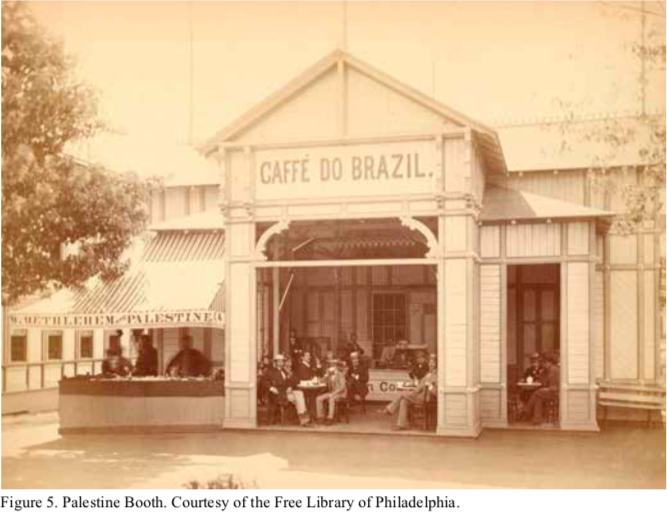
The Bethlehem Bazaar The origins of the Bethlehem Bazaar are more obscure, but we do know it appeared after the Jerusalem Bazaar, springing up, according to one press account, “to sell gew-gaws in opposition to the natives of Jerusalem who have a bazaar close by.”26 It is rarely mentioned in newspaper accounts, perhaps because of its late start or because it was seen as part of the Jerusalem Bazaar (some accounts say the two booths were adjoining), yet several articles testify to its existence. James McCabe described two booths in which “some enterprising Syrian merchants offer for sale articles of olive wood and mother-of-pearl from Jerusalem, Bethlehem and other parts of the Holy Land.”27 Another reported: “Hard by [the Turkish Café] there are two booths, one offering for sale a variety of olive wood articles from Bethlehem, and the other rosaries, trinkets and other keepsakes from Jerusalem.”28

The Bethlehem Bazaar’s probable owners, Michel and Beshara Dabdoub, scions of an important Bethlehem Catholic mercantile family,29 had arrived in Philadelphia armed with an approval from the Ottoman authorities and goods to sell, and had already paid customs duty in Philadelphia. For some reason, however, fair authorities withheld permission to build. In mid-April, the Dabdoubs asked Aristarchi to intercede so that they could sell their “articles fantasies” at the fair.30 They probably meant objects made of mother-of-pearl, on which the Dabdoub family’s mercantile success rested, or a mixture of mother-of-pearl and olive wood. They must have finally received permission because, as noted, a booth was being built “in opposition to” the Jerusalem booth at the end of May. By that time, though, the Jerusalem Bazaar had garnered all the attention and was already doing a brisk business.
To complicate things further, a second group from Bethlehem – the brothers Zacariah, Michael, and Habib Banayotte/Panayotti – were also in Philadelphia and also waiting for permission to build.31 They had left Palestine in March with more than sixty dozen small objects (brooches, studs, rosaries, crosses, and so forth) worked in mother-of-pearl, olive wood, and seeds, as well as dozens of larger objects (tableaux and large medallions in mother-of-pearl, large olivewood crosses, and sets of Turkish coffee cups). They cleared customs in Philadelphia in April and in early June, a month after the fair opened and after the Bethlehem booth was already under construction, they were still awaiting permission.32 First Secretary Baltazzi, who with Rustem had moved to Philadelphia to oversee the Ottoman installations, urged the commission to allow the Banayottes to proceed. “It is desirable,” he wrote, “to have the space assigned near the Turkish Coffee House and as near to the Jerusalem Bazaar as possible.”33 The director-general granted permission on 5 June, subject to submission and approval of the plans, along with the proviso that 15 percent of all receipts be paid to the commission. Where or whether they did build is unknown. Did they join forces with the Dabdoubs in the Bethlehem Bazaar or build something separate? One article describes the building of a booth in July: “Near the Jerusalem Bazaar has just been erected and opened, the ‘Bethlehem Judea Bazaar,’ where articles of pearl and olive wood are for sale by Bethlemites [sic] in Palestine costume.”34 This is the only evidence suggesting that the Panayottis built their own booth.35 Thus, two (or perhaps three, if the Mikels were also at the fair; see note 20) Bethlehem families were present at the fair, one or all of whom ran the Bethlehem Bazaar(s) and may have supplied the mother-of-pearl goods on display in the main building, but none of whose names appear in the official catalogue, contemporary news accounts, or elsewhere.
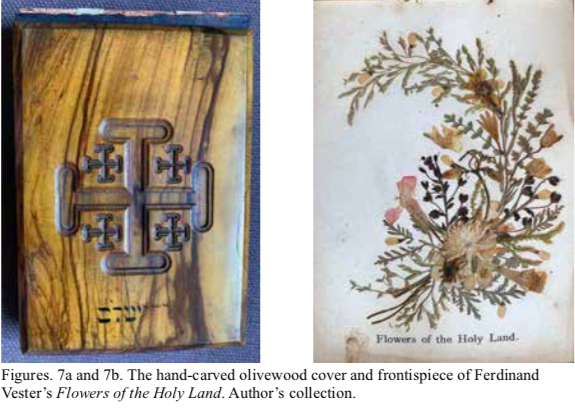
The only extant photograph of the Palestine presence at the fair shows a single booth attached to the exterior of (and perhaps sublet from) the Brazilian Café (see Figure 5 above). Neither the booth nor the café is mentioned in any document or shown on any map, so we do not know where it was located. The stall has a striped awning emblazoned with the combined rubric “Jerusalem, Bethlehem, and Palestine,” which may indicate that the Jerusalem and Bethlehem Bazaars merged at some point during the fair and moved to a different (perhaps cheaper) location. Their goods certainly overlapped and would not have been difficult to incorporate into one display. Or perhaps the Panayotti brothers hurriedly attached their stall to an already-existing building in a desperate attempt to catch up to their competitors: the three blurry figures may be the three brothers. Or it may have been one of the unauthorized installations springing up on the grounds, competing with the two legitimate booths by selling fake goods from “the Orient.”
An account written a year after the fair closed recalls that the Jerusalem Bazaar, along with the Tunisian Café and Algerian Bazaar, was so profitable that unauthorized imitations sprang up around the fairgrounds: The above establishments opened with the Centennial, and did a prosperous business immediately. This prosperity was noted by inventive Americanized subjects, who began to open rival bazaars. These innovations gradually and steadily increased, until at the close they were located in all the most prominent places on the grounds, and trinkets from “the Orient” were made by the bushel in West Philadelphia and “down East.” The uninitiated came, and were easily persuaded to exchange their money for these imitations. As the number of visitors increased, soda-water stands were metamorphsed [sic] into genuine Jerusalem – so the proprietors said – bazaars, and many of the attendants, who said they were born in Turkey, had the rich brogue of the Emerald Island. They continued to come, and were at the close pronounced nuisances and abominations by all.36
NON-PALESTINIAN PARTICIPANTS
The Jerusalem and Bethlehem Bazaars also saw competition from legitimate merchants among the Ottoman exhibitioners who traded on the allure of the Holy Land. It has been said that H. H. Jessup, the Presbyterian missionary in Beirut, sent Christians from the Koura to the fair: “For six months they supervised the Turkish exhibits in the Main Hall, worked in the Turkish Pavilion and Café, and sold olive-wood artifacts from the Holy Land at the ‘Bethlehem and Palestine’ booth.”37 However, we know the name of only one person who claimed to be among them: Khalil Sallom, who became an agent for the travel company Thomas Cook and Son when he returned to Philadelphia later in the century.38 If there were others, they remain unidentified.
Cook’s travel company had begun to organize tours to Palestine in 1869, and Jaffa and Jerusalem were its main staging posts. The company erected an impressive ticket office at the fair with an array of white tents set up behind the building (the same tents as those used on the Holy Land tours), which Cook called “Palestine and Jerusalem Camp.” In addition to advertising tours and selling tickets, there was a display of “ornamental articles manufactured in Palestine” that were probably for sale.39 Dragoman Rolla Floyd, who later became Cook’s competitor and implacable enemy, came from Jaffa to work in the building and lend a note of authenticity and authority to the sales pitch. He was to guide a special Cook’s tour of the Holy Land due to leave Philadelphia on the day the fair closed.40
It may have been Thomas Cook who encouraged Vester to participate in the fair. Cook knew Vester and later sold his products in England.41 Although there is no evidence that Vester himself was present at the fair, his company showed a large number of olivewood products, divided by the fair authorities into three categories: home goods (from tables and shelves to napkin rings and candlesticks); personal items (cuff buttons, book and album covers, cases and boxes of various kinds, toys, and rosaries); and library furnishings (desks, inkstands, penholders, paperweights).42 The company won two commendations “as a fine display of fancy goods in olive wood in a great variety of forms,” distinguished by their “superior workmanship and finish.”43 In the only photograph of the Turkish section in the main building, dozens of Vester’s olivewood rosaries sit on trays, spill out of boxes, and hang from the display case of Antoine Bedros’s tobacco company, alongside olive oil soap and perfumes, while a splendid array of Turkish rugs delineate and decorate the back and side walls of this portion of the exhibit. In the United States section of the main building, meanwhile, a Philadelphia merchant, Paul Weintraub, showed “fancy articles of olive wood from Jerusalem.”44 Weintraub, “late Guide and resident of Jerusalem,” had travelled to Philadelphia a few years before the fair with the clear intention of staying (he brought his wife and children) and must have already been in business when he applied for a spot in the American section.45 After the fair, he continued to sell olivewood items (“direct from the Holy Land . . . at reasonable prices”) and fancy goods from his store on South Tenth Street until his death in 1882.46
THE IMPACT OF THE CENTENNIAL FAIR
Palestine merchants attended subsequent fairs, but never in great numbers. Vester went on to show goods at the Louisville fair in 1885, the Chicago fair of 1893, from which he took home a medal, and the Atlanta fair of 1895. The Dabdoubs participated in the Louisville and Chicago fairs, and the St. Louis fair of 1904. Also at the Louisville fair was someone called Selah Mousour (perhaps Mansur?) who sold Jerusalem relics and Oriental goods.47 A press account described him as a “soft-spoken individual . . . all over the building, with his Jerusalem curiosities, his ‘charms of the Turkish ladies,’ his amulets, his sandal wood ornaments and ottar-of-roses scent bottles, all of which he is invariably ‘selling to-day at half price.’”48 The Panayottis attended the Chicago fair and, when it closed, carried their goods around the country, advertising “olive wood, Turkish rugs, jewelry, [and] perfumes” as they went.49 Although Jacob Norris mentions the participation of the Handal brothers in the 1853 New York Exposition, nothing and no one in the official catalogue can be construed as coming from Palestine. Solomon Handal did go to the Chicago fair and settled in New York after it closed.50
The 1904 St. Louis fair, with its thirteen-acre full-scale replica of selected parts of the Old City of Jerusalem was the most spectacular exploitation of America’s hunger for knowledge of and goods from the “Holy Land.” Although all the shareholders and managers of the Jerusalem Exhibit Company were Americans, more than “five hundred natives of Jerusalem – Jews, Moslems, Christians – are conducting the trades they were accustomed to carry on in Palestine.”51 Living inside the ersatz city, they acted as guides, merchants, craftsmen, and entertainers, all clad in “native dress.”52 How many were really Jerusalemites is impossible to say: most of the “natives” at the fair whose names we know were Syrian Christians, some perhaps from Jerusalem, but many more from Mount Lebanon and others coming from their homes in the United States.53 Rehav Rubin cites a doubling of the value of goods exported from Jaffa in 1903 and 1904, however, indicating that many goods from Palestine were being sent to the fair.54 But if prior fairs are any indication, these goods were being sold by Syrians, not Jerusalemites. The Jerusalem Exhibit Company was plagued by problems and ended in bankruptcy, leaving many of those who had been brought from the Middle East in precarious circumstances.55
Adele Younis, describing the successes of the Arab presence at the Centennial Fair, averred that “Syrian entrepreneurs discovered new markets in America, for the fair developed new tastes and increased the demand for new products.”56 Jacob Norris, however, cautions that although the fair may have been a springboard for Bethlehem mother-of-pearl merchants in America, its “influence should not be overstated.”57 Still, the Jerusalem Bazaar’s frequent mentions in the press, its imitators, the three Bethlehem merchant families who were at the fair, the fake “Holy Land goods” that began to be produced, and the fact that Palestine goods and merchants continued to be seen at later fairs all point to their success and testify to the attraction that Holy Land goods held for the American public.
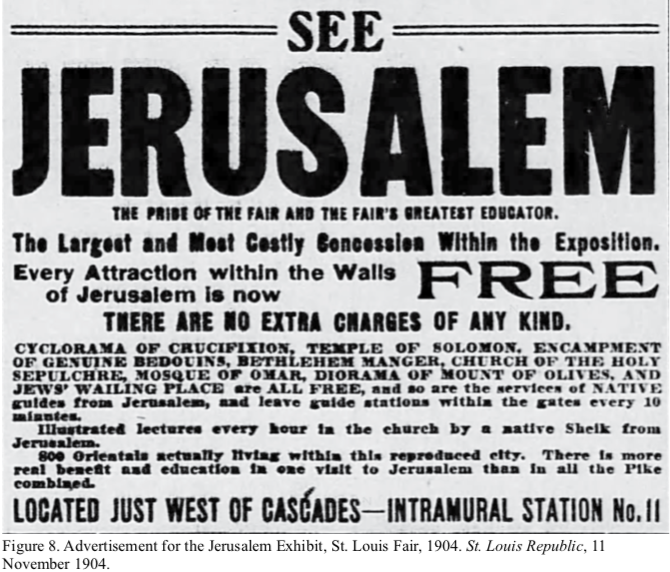
In fact, Holy Land goods became and remained a staple for Syrian peddlers and Syrian suppliers in the United States in the nineteenth and early twentieth centuries. Most common were olivewood items, including rosaries, crosses, cigarette cases, and the like – exactly those items that were shown and sold at the Centennial Fair – which were light and easy to pack, lending themselves to door-to-door sales. They appealed to Christian Americans in all parts of the country and were especially popular in Catholic enclaves. The fact that Syrian peddlers often claimed (or were assumed) to be from the Holy Land added authenticity to their sales pitch.58 As for those actually born in Palestine, very few immigrated. Of the approximately fifteen thousand Arab immigrants in the 1900 federal census, fewer than two dozen gave their birthplace as Jerusalem, Bethlehem, or Palestine.59 The 1908–9 Syrian Business Directory lists only three businessmen from Bethlehem and four from Jerusalem (among more than three thousand names).60
The Dabdoubs and Handals, two Bethlehem families that immigrated to the United States in the nineteenth century, turned the manufacture and importation of Holy Land goods into a big business.61 Family members constantly traveled back and forth to Bethlehem, supervising their factories, organizing the shipment of goods, and expanding their markets in North and South America. Maronite merchants from Mount Lebanon did the same. They bought Holy Land goods from Palestine suppliers until they began to manufacture their own. All of these merchants, whether from Palestine or Mount Lebanon, soon broadened their reach, either becoming manufacturers of a broad range of religious goods or becoming large importers-exporters and wholesalers of general dry goods. Thus, the Centennial Fair, as difficult as it may have been for the Palestine merchants, did provide the first venue for the display of Holy Land goods by “natives,” laying a foundation for their success in the global trading economy.
Linda K. Jacobs is an independent scholar in New York City. She is the author of three books (all published by KalimahPress): Digging In: An American Archaeologist Uncovers the Real Iran (2011); Strangers in the West: The Syrian Colony of New York City, 1880–1900 (2015); and Strangers No More: Syrians in the United States, 1880–1900 (2019).
Endnotes
- 1 Its official name was the International Exhibition of Arts, Manufactures, and Products of the Soil and Mine.
- 2 Correspondence between A. T. Goshorn, director-general of the Centennial Commission, and the members of the Ottoman committee, City of Philadelphia, Department of Records, City Archives, United States Centennial Commission, Centennial Exhibition of 1876 Records, Record Groups 230 and 231 (hereinafter Philadelphia City Archives), online at hdl. library.upenn.edu/1017/d/pacscl/PCA_ PCARecordGroups230and231 (accessed 5 October 2019). A not-quite-complete set of the photographs commissioned for the fair are held at the Free Library of Philadelphia, online at libwww.freelibrary.org/digital/ collection/centennial-exhibition (accessed 5 October 2019).
- 3 The delayed opening can be blamed on their late start and the complexity of the arrangements (gathering goods from all over the empire, arranging for shipping them five thousand miles, dealing in a foreign language). In a letter to Aristarchi dated 15 June 1876, Goshorn explains that he was unable to assign an Ottoman to the committees of judges “owing to the uncertainty until quite recently as to the final participation of your country and the absence of information as to the extent of your participation in the Exhibition.” In fact, two men suggested by Aristarchi did become judges. Philadelphia City Archives.
- 4 This number included all aisles and walkways, so the display space was actually smaller. They had originally been promised a larger space but were downgraded before the fair opened. Aristarchi protested, but to no avail. Again, their late start may have been the reason their space was reduced, or the decision may have been a symptom of the generalized contempt in which the Ottoman Empire was held by the American officials, as evidenced as well by the dearth of official photographs, tiny number and low status of the awards, and neglect or rebuffs by the Centennial Commission to several of Aristarchi’s requests.
- 5 The number of exhibitors was surpassed only by the United States and Great Britain. The government of Damascus, for example, exhibited “wheat, maize, barley, white sorghum, etc.,” while Mme. Kamile of Tripoli, Syria, showed “embroidered napkins.” United States Centennial Commission 1876, Official Catalogue, Complete in One Volume (Philadelphia: John R. Nagle, 1876) (hereinafter Official Catalogue). In contrast to this vast array of goods shown by both governmental and private institutions, all objects in the Egyptian and Tunis sections were said to be provided by their respective governments.
- 6 Pascal Sébah of Constantinople and the Kova Brothers of Beirut contributed the photographs. Although not listed in the Official Catalogue, the Kova Brothers won a commendation for their photographs of “Arabic Costumes of Syria.” The judges found it “an extremely interesting collection.” Philadelphia City Archives.
- 7 “The Great Show,” Intelligencer-Journal (Lancaster, PA), 1 August 1876, 2. The complete absence of Bethlehem merchants in the Official Catalogue seems to contradict Jacob Norris’ epigram taken from Malouf: “The first to enter North America, in search of trade, were the traders of Bethlehem; they carried their wooden, pearl-embellished handcrafts to the Philadelphia exhibition of 1876. They returned to their country with an abundance of wealth, and prompted others to follow in their footsteps.” Jacob Norris, “Exporting the Holy Land: Artisans and Merchant’s Migrants in Ottoman Bethlehem,” Mashriq & Mahjar 1, no. 2 (2013): 14. Perhaps Malouf was referring only to the Bethlehem Bazaar(s).
- 8 Vester played a key role in the building of the first Lutheran church in Jerusalem, and the house he built for himself, one of the first outside the walls, later became the American consulate. Bertha Spafford Vester, Our Jerusalem: An American Family in the Holy City, 1881–1949 (Garden City: Doubleday, 1950), 84.
- 9 The government of Syria brought Dead Sea salt, which must have come from Palestine.
- 10 The distinction between the “high” – the educational and informative – and the“low” – the money-making – would be increasingly marked at subsequent fairs. Their comingling on the grounds of the Centennial eventually gave way to a physical separation that reached its apogee at the Chicago fair of 1893, at which the Midway Plaisance lay completely outside the confines of the so-called White City, becoming its own attraction and earning all the money; many visitors never bothered to see the actual fair. “The Midway” became a byword for fun (the Ferris Wheel made its first appearance there), and it served as a model for the amusement parks and carnivals – eschewing any higher purpose other than entertainment and profit – that emerged at the end of the nineteenth century and continue to be built to this day.
- 11 Boker to Goshorn, datelined “Constantinople, March 17, 1875.” Philadelphia City Archives.
- 12 The café was in the charge of Pierre Barthélemy and Victorine Vallauri, both of Constantinople. The Vallauri family were well-known confectioners. James McCabe wrote: “Pipes are here in abundance, and you may enjoy the happiest of smokes for a mere pittance.” James D. McCabe, The Illustrated History of the Centennial Exhibition (Philadelphia: National Publishing, 1876), 616. The coffee was said to be “as clear as amber, as black as ebony, as fragrant as the perfumes from ‘Araby the blest,’ and strong enough to satisfy a man of average nerves for the remainder of the day.” “Coffee Az-Iz Coffee: Opening of the Turkish Cafe,” Times (Philadelphia), 7 June 1876, 4.
- 13 Philadelphia City Archives. The proprietors of the bazaar were G. Ludovic and P. Barthélemy, Constantinople merchants. The firm of “Ludovic and Vallauri” (perhaps Victorine’s husband, Edouard), showed many goods in the Ottoman section of the main building. After the fair, the remaining goods from the Turkish Bazaar were auctioned off. Advertisement, Boston Globe, 22 December 1876, 3. The Turkish Bazaar may have been staffed by Syrians from the Koura (see below and notes 38 and 39).
- 14 “Are the American People Thieves?” Philadelphia Inquirer, 23 October 1876, 4.
- 15 Goshorn to Aristarchi, dated 6 August and 14 August 1876, Philadelphia City Archives.
- 16 Official Catalogue, Part III, 122, 124. The “1⁄2” implies they were late additions to the catalogue.
- 17 “The Palestine Bazaar,” Times (Philadelphia), 24 May 1876, 2.
- 18 “The Genuine and the Bogus,” Press (Everett, PA), 5 September 1876, 3. Although the men in the Turkish Café spoke only Greek, according to Taylor, those in the Jerusalem Bazaar answered “with alacrity” when he spoke to them in Arabic, implying that the former were fooling the public, while the latter were the genuine article.
- 19 “The Palestine Bazaar,” Times (Philadelphia), 24 May 1876, 2. This was before the Bethlehem Bazaar was open and shows that the Jerusalem Bazaar was already successful.
- 20 A member of the Bethlehem Mikel family was also on board; he may have been going to the fair to sell mother-of-pearl goods, but nothing more is heard of him.
- 21 “Among the Turks,” Times (Philadelphia), 19 April 1876, 1. Jamal claimed that the “little grass plot” on which the booth was being built was acquired for them by the good offices of Richard Smith, a partner in one of the oldest type foundries in the United States, whom Jamal had guided in Palestine.
- 22 “World’s Exposition,” Auburn Daily Bulletin, 2 September 1876, 3.
- 23 Signing with a cross (as the Christian immigrants often did) usually indicated illiteracy in both Arabic and English, but we know from later documents that Nachly was literate in Arabic; perhaps it did not make sense to him to sign his intention papers in a script no one could read. One note says that “Ten of the Turks, belonging to the Turkish bazaar at the Centennial, filed their petitions.” Reading Times (Reading, PA), 11 August 1876, 2. Who these ten might have been is not known.
- 24 Five stereoscopic photos of David Jamal c. 1900 can be found online at calisphere.org/ item/ark:/13030/kt2870283q/ (accessed 4 September 2019).
- 25 A family of “Kourts” emigrated from Jerusalem to the United States around 1910, but whether they were related to the earlier visitors is not known.
- 26 “Sunday at the Show,” Times (Philadelphia), 29 May 1876, 1.
- 27 McCabe, Illustrated History, 617.
- 28 “World’s Exposition,” Auburn Daily Bulletin Auburn, NY), 2 September 1876, 3.
- 29 Norris, “Exporting the Holy Land.”
- 30 Philadelphia City Archives.
- 31 Jacques/Giacamo Panayotti was dragoman for the American consulate at Jerusalem from 1871–76 and perhaps facilitated his relatives’ trip to Philadelphia. Ruth Kark, American Consuls in the Holy Land, 1832–1914 (Jerusalem: Magnes Press, 1994), 346.
- 32 Philadelphia City Archives. Those who brought goods intended for sale were required to pay customs duty on entry, while duty was waived for all exhibitors, as long as they took their goods home with them. If they sold them after the fair closed, customs duty officers were on hand to assess what they owed. Most of the items in the Middle Eastern displays went on sale after the fair, usually in other cities to evade the customs officers, or were given to American museums; no one wanted to pay for return shipping.
- 33 Letter datelined, “Philadelphia, June 1, 1876.” Philadelphia City Archives.
- 34 “From Our Correspondents: The Centennial City,” Monmouth Democrat (Monmouth, NJ), 20 July 1876, 3.
- 35 Land allocations by the Commission may indicate there were three booths: the “Jerusalem, Palestine Bazaar” was allocated .012 acres (about 525 square feet) and the “Jerusalem Bazaar” .002 acres (about 87 square feet); the former may have been the combined Jerusalem/Bethlehem Bazaars, the latter, the Panayotti Bazaar.
- 36 A. J. Burr, Memorial of the International Exhibition (Hartford: L. Stebbins, 1877), 731–32. One endlessly reprinted quip was: “‘Paris fashions,’ like olive wood articles from Jerusalem, are of New York manufacture.” Huntsville Independent (AL), 7 December 1876, 1.
- 37 See online at ww1.antiochian.org/node/21323 (accessed 1 September 2019).
- 38 See online at ww1.antiochian.org/node/21323 (accessed 1 September 2019). The source for this story was Sallom’s granddaughter.
- 39 Official Catalogue, Part III, 131. Since only a year later, Cook was selling Vester’s olivewood items in London (see note 42), it seems likely that the items on display at Cook’s were Vester’s and that they were indeed for sale.
- 40 Floyd was one of the few remaining members of an American millenarian colony that had settled in Jaffa earlier in the century. He worked for Cook for seven years before going out on his own. Rolla Floyd, Letters from Palestine: 1868–1912, ed. Helen Palmer Parsons (n.p., 1981).
- 41 “War Victims in Palestine,” Times (London), 27 November 1877, 10. Letter to the Editor from Thomas Cook regarding the £ 1,000 worth of olivewood goods that he had had shipped to London from Vester in Jerusalem. Rolla Floyd manned Cook’s stall at the Crystal Palace, sitting behind a seven-by- ten-foot counter “covered with Olive Wood articles from Jerusalem.” Floyd, Letters, 30.
- 42 A reporter praised the olivewood “boxes, card-cases, crosses, book-holders, paper- cutters, reading-desks and numerous articles of like character.” “The Great Show,” Intelligencer-Journal (Lancaster, PA), 1 August 1876, 2.
- 43 Turkey took home only eighty-six awards out of a total of thirteen thousand, and they were all “diplomas,” rather than medals. Nevertheless, the winners proudly advertised these honors.
- 44 Official Catalogue, Part III, 127.
- 45 Although Weintraub and his wife may have been Jewish, the children were baptized and raised as Episcopalians in Philadelphia.
- 46 Advertisement, Delaware County Daily Times (Chester, PA), 29 December 1877, 3.
- 47 Ryan S. Bush, Louisville’s Southern Exposition: 1883–1887 (Charleston: History Press, 2011), 70.
- 48 “The Passing Show,” Courier-Journal (Louisville, KY), 19 August 1885, 6.
- 49 Seattle Post-Intelligencer, 28 August 1894, 8.
- 50 Norris, “Exporting the Holy Land,” 28.
- 51 “Jerusalem at the World’s Fair,” Pulaski County Democrat (Waynesville, MO), 17 June 1904, 1. Some estimated there were a thousand “natives” from Jerusalem.
- 52 “The train bringing the dromedaries will also carry a troupe of fifty natives, who are to be part of the exhibit in the reproduced Holy City.” “Ship Camels for Jerusalem Exhibit,” St. Louis Globe-Democrat, 21 March 1904, 4.
- 53 Keith Feldman looked carefully at the names and confirms this conclusion. See Keith P. Feldman, “Seeing Is Believing: U.S. Imperial Culture and the Jerusalem Exhibit of 1904,” Studies in American Jewish Literature 35, no. 1 (2016): 108–10.
- 54 Rehav Rubin, “When Jerusalem Was Built in St. Louis: A Large Scale Model of Jerusalem in the Louisiana Purchase Exposition 1904,” Palestine Exploration Quarterly 132, no. 1 (2000): 64.
- 55 Three separate fires destroyed parts of the exhibition. The company repeatedly petitioned the fair administration to allow them to be open on Sundays to increase ticket sales for attractions within the “city,” but was rebuffed. Charging extra admissions turned out to be a mistake that was only remedied in September, when they made the attractions free, but by then it was too late. Their frequent advertisements in the local newspapers show increasing desperation as the season wore on. The company was sued by merchants, suppliers, and employees (both “native” and American) and went into receivership in August. Trying to recoup their losses, the company sued the fair management for failure to live up to
its agreements, but lost the case. At the close of the fair, the company auctioned off everything in its possession, including the stock of its “Antique Museum” as well as the materials from which the booths were constructed, but ended up bankrupt. Their creditors received pennies on the dollar. - 56 Younis conflated the Ottoman installation with the Tunis and Egyptian displays, and Eric Davis did not distinguish between the installations in the main building with those outside (Davis, in fact, placed the Turkish Café in the main building), leading both to misinterpret the Ottoman presence. They
do not mention Palestine. Adele L. Younis, The Coming of the Arabic-Speaking People to the United States (New York: Center for Migration Studies, 1995), 142–49. Eric Davis, “Representations of the Middle East at American World Fairs, 1876–1904,” in The United States and the Middle East: Cultural Encounters, ed. Abbas Amanat and Magnus T. Berhardsson (New Haven, CT: Yale Center for International and Area Studies, 2002), 342–85. - 57 Norris, “Exporting the Holy Land,” 28. 58 B. K. Forzley, who emigrated from the
- Baqa‘a in 1898, was nicknamed “Jerusalem” by his customers, even though he did not sell Holy Land goods. Bashara K. Forzley, An Autobiography (Worcester, MA: self- published, 1958), 8.
- 59 Of course, their numbers could be hidden in misattributions: one immigrant from Nazareth was said to be born in Greece. A cursory look at the census data also shows that fewer than 200 Jews from Palestine had immigrated by 1900.
- 60 S.A. Mokarzel and H. F. Otash, The Syrian Business Directory, 1908–1909 (New York: al- Hoda, [1909]).
- 61 The Dabdoub family settled in the United States in 1885 after the Louisville fair, first in New Jersey and then in New York City as dealers of religious goods. Michel Dabdoub died on his way to Palestine in 1898, when the SS Bourgogne sank near Nova Scotia. Solomon Handal immigrated in 1893 for the Chicago fair and was soon joined by other family members. They too settled in New York.

